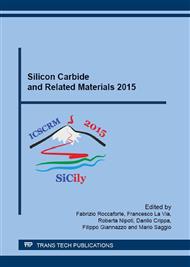p.1141
p.1145
p.1149
p.1153
p.1158
p.1165
p.1170
p.1174
p.1178
Abnormal Raman Spectral Variation with Excitation Wavelength in Boron-Doped Single-Crystalline Diamond
Abstract:
The Raman spectra of boron-doped single-crystalline diamond were measured at excitation wavelengths between 364.0 and 1064.0 nm and found that the first-order Raman band at 1332 cm-1 shifts to the low-frequency side, broadens, and develops a derivative-like lineshape as the boron concentration increases. The derivative-like lineshape can be explained by Fano interference. Furthermore, I found that the asymmetric lineshape changes between excitation wavelengths of 514.5 and 785.0 nm. From a comparison of the normalized relative Raman intensity as a function of the excitation energy and the density of states (DOS) in the valence band in the B-doped diamond calculated previously by the coherent potential approximation, the abnormal change in the Raman lineshape is attributed to a change in the DOS in the valence band at approximately 2.0 eV. Raman spectroscopy provides us with extensive information on carrier concentrations, and electronic band structures of B-doped diamond.
Info:
Periodical:
Pages:
1158-1161
Citation:
Online since:
May 2016
Authors:
Price:
Сopyright:
© 2016 Trans Tech Publications Ltd. All Rights Reserved
Share:
Citation:


